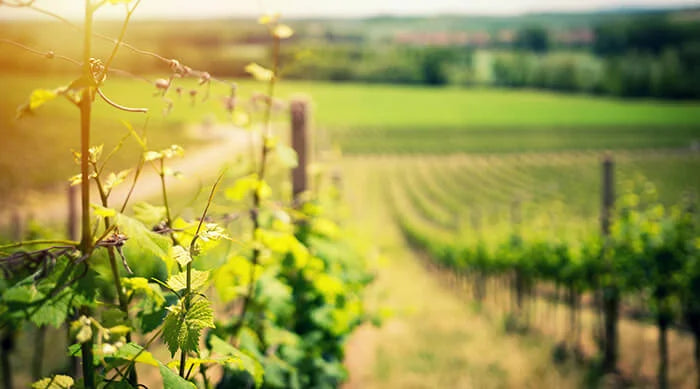Wine and the Earth

Earth Day, observed on April 22nd since its inception in 1970, is celebrated globally by over 1 billion people through various events. During this time, we invite you to learn more about how wineries around the world are approaching viticulture and winemaking in ways that can reduce environmental impact, promote longevity and how climate change affects grape growing and some ways winemakers tackle this problem.
Climate Change Impact
Climate change is significantly impacting grape growing and wine production. Vintage variation has always been a factor to consider in winemaking, with terms such as an ‘excellent vintage’ or ‘average vintage’ commonly used to describe yearly fluctuations. However, the escalating temperature, with an average increase of 0.2C per decade, presents new challenges.
The rise in temperature is leading to hotter weather, increased drought, and elevated fire risks globally. While warmer temperatures can potentially enhance sugar ripening and concentrate flavours in grapes. It can also disrupt the traditional styles of wines associated with cooler climates. Moreover, milder winters can prompt vines to emerge from dormancy earlier, leaving them vulnerable to frost damage.
To adapt to these changes, winemakers and viticulturists are implementing various strategies. These can include planting different rootstocks or grape varieties more suited to warmer conditions, adjusting harvest times to pick grapes earlier, and modifying vine training techniques to manage sunlight exposure. Additionally, they are not just focusing on the current vintage but are also planning for the decades ahead, anticipating how climate shifts will continue to impact grape cultivation.
Sustainable Practices
Sustainable winegrowing encompasses a broad spectrum of practices that are both environmentally friendly and economically viable. These initiatives, implemented both in the vineyard and winery, aim to conserve water, promote soil health, and safeguard local ecosystems. Some of the various techniques listed are listed below.
In the Vineyard:
· Utilization of Cover Crops: these crops can lend to enrich soil nutrients and prevent erosion.
· Water Management: techniques such as drip irrigation, dry farming, or catching rain runoff reduce water usage and help with conservation.
· Pest Management Strategies: Natural pest control methods, including the introduction of animals that prey on harmful insects, are employed to reduce the need for chemicals.
In the Winery:
· Waste Management: Implementing recycling programs, composting grape pomace and winery waste and minimizing packaging.
· Green Building Design: Designing or retrofitting winery buildings to meet energy-efficient standards, such a proper insulation, passive heating, and natural lighting.
· Sustainable Sourcing: Lowering carbon footprint by sourcing from local suppliers and using recycled materials for packaging and labels.
Certification programs have been established in many countries to recognize wineries that adhere to sustainable practices. In Canada, notable examples include the Sustainable Winegrowing British Columbia (SWBC) and Sustainable Winegrowing Ontario (SWO), as well as the California Certified Sustainable Winegrowing (CCSW) program in the United States. Wineries that obtain certification can proudly display it on their wines, signaling their commitment of sustainable and responsible environmental practices.
Organic Winemaking
Organic winemaking practices eschew toxic pesticides, herbicides, and synthetic fertilizers, although the specific laws and regulations governing them may vary from one country to another. Instead, these vineyards employ alternative methods, such a cover crops and naturally derived sprays, to maintain the health of their vines. While managing these vineyards may pose challenges due to their reliance on more natural methods, the benefits include the promotion of healthy soils and flourishing biodiversity. In the winery, emphasis is placed on avoiding artificial coloring and synthetic preservatives. Instead, natural or plant-based fining agents are utilized to underscore the expression of terroir in the wine.
Biodynamic Winemaking
Biodynamic winemaking embodies a holistic philosophy and at its core lies a profound acceptance that the vineyard is a living, self-sustaining organism. Similar to organic viticulture, biodynamic farming embraces prioritizing natural and organic materials instead of synthetic products. Central to this approach is nurturing soil health to create a vibrant biodiversity. This process is done through composting, cover cropping and the application of herbal preparations. A distinctive aspect of biodynamic winemaking is the adherence to a biodynamic calendar, that connects with the cycles of nature.
This calendar, synchronized with the movements of the stars, delineates four elemental phases:
- · fruit days
- · root days
- · flower days
- · leaf days
Each phase holds significance, guiding farmers in decisions such as pruning and harvesting. In essence, biodynamic winemaking celebrates a deeper understanding of the interconnectedness between vine, soil, and cosmos, yielding wines that have authenticity, vitality, and a sense of terroir.
- Samantha Nelmes







